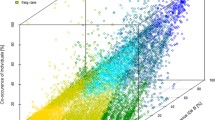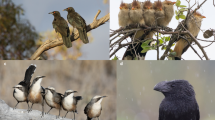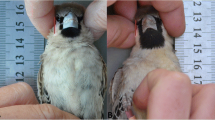Abstract
A complex social life serves as one of the main driving forces behind the evolution of higher cognitive abilities in vertebrates. In birds, however, data are primarily derived from captive animals, which strongly contrast with free-flying birds in terms of the number of interaction partners as well as available space. In captivity, Common Raven Corvus corax, nonbreeder groups show strong social bonds and complex tactical manoeuvring, whereas wild non-breeders are thought to resemble anonymous aggregations. Over 2 years, we observed a free-flying population of Ravens that visits a game park in the northern Alps. We here focus on the daily fission–fusion dynamics, individual spacing, and the influence of spacing on the birds’ agonistic and affiliative behaviour. The composition of marked Ravens in the local population changed slowly but constantly, although often remaining stable for several weeks. Birds only flocked for feeding, mobbing and roosting, and spent the rest of the day in loose aggregations, characterised by temporary small subgroups of 2–5 individuals. Aggression was high during crowd foraging but low outside of a feeding context. Affiliative behaviours, such as sitting within reaching distance, allo-preening and social play, were observed particularly in the small subgroups. These findings suggest that Raven aggregations are not as unstructured as previously thought. Birds may spend time and/or interact affilliatively with multiple individuals during the day. This, along with temporary stability in group composition, provides the opportunity for social relationships to develop, and enables the existence of socialised subgroups within free-flying Raven aggregations.


Similar content being viewed by others
References
Amici F, Aureli F, Call J (2008) Fission-fusion dynamics, behavioural flexibility, and inhibitory control in primates. Curr Biol 18:1415–1419
Aureli F, Schaffner CM, Boesch C, Bearder SK, Call J, Chapman CA, Connor R, Di Fiore A, Dunbar RIM, Henzi SP, Holekamp K, Korstjens AH, Layton R, Lee P, Lehmann J, Manson JH, Ramos-Fernandez G, Strier KB, van Schaik CP (2008) Fission-fusion dynamics, new research frameworks. Curr Anthropol 49:627–654
Barrett L, Henzi P, Dunbar R (2003) Primate cognition: from ‘what now?’ to ‘what if?’ Trends Cogn Sci 7:494–497
Beauchamp G (1999) The evolution of communal roosting in birds: origin and secondary losses. Behav Ecol 10:675–687
Beauchamp G (2010) Relaxed predation risk reduces but does not eliminate sociality in birds. Biol Lett 6:472–474
Boarman WI (2003) Managing a subsidized predator population: reducing common raven predation on desert tortoises. Environ Manag 32:205–217
Bond AB, Kamil AC, Balda RP (2003) Social complexity and transitive inference in corvids. Anim Behav 65:479–487
Bond AB, Kamil AC, Balda RP (2007) Serial reversal learning and the evolution of behavioral flexibility in three species of North American corvids (Gymnorhinus cyanocephalus, Nucifraga columbiana, Aphelocoma californica). J Comp Psychol 121:372–379
Bugnyar T (2011) Knower-guesser differentiation in ravens: others’ viewpoints matter. Proc R Soc Lond B 278:634–640
Bugnyar T, Heinrich B (2005) Ravens, Corvus corax, differentiate between knowledgeable and ignorant competitors. Proc R Soc Lond B 272:1641–1646
Bugnyar T, Heinrich B (2006) Pilfering ravens, Corvus corax, adjust their behaviour to social context and identity of competitors. Anim Cogn 9:369–376
Bugnyar T, Kotrschal K (2002) Observational learning and the raiding of food caches in ravens, Corvus corax: is it ‘tactical’ deception? Anim Behav 64:185–195
Byrne RW, Bates LA (2007a) Brain evolution: when is a group not a group? Curr Biol 17:R884
Byrne RW, Bates LA (2007b) Sociality, evolution and cognition. Curr Biol 17:R714–R723
Byrne RW, Whiten A (1988) Machiavellian intelligence. Social expertise and the evolution of intellect in monkeys, apes and humans. Oxford University Press, New York
Caffrey C (2000) Marking crows. N Am Bird Bander 26:146–148
Canestrari D, Marcos JM, Baglione V (2005) Effect of parentage and relatedness on the individual contribution to cooperative chick care in carrion crows Corvus corone corone. Behav Ecol Sociobiol 57:422–428
Carlisle TR, Zahavi A (1986) Helping at the nest, allofeeding and social status in immature arabian babblers. Behav Ecol Sociobiol 18:339–351
Connor RC, Heithaus MR, Barre LM (1999) Superalliance of bottlenose dolphins. Nature 397:571–572
Dall SRX, Wright J (2009) Rich pickings near large communal roosts favor ‘gang’ foraging by juvenile common ravens, Corvus corax. PLoS ONE 4:e4530
Dally JM, Clayton NS, Emery NJ (2006) The behaviour and evolution of cache protection and pilferage. Anim Behav 72:13–23
de Waal FBM, Tyack PL (2003) Preface. In: de Waal FBM, Tyack PL (eds) Animal social complexity: intelligence, culture, and individualized societies. Harvard University Press, Cambridge, pp ix–xiv
Diamond J, Bond AB (2003) A comparative analysis of social play in birds. Behaviour 140:1091–1115
Drack G, Kotrschal K (1995) Aktivitätsmuster und Spiel von freilebenden Kolkraben Corvus corax im inneren Almtal/Oberösterreich. Monticula 7:159–174
Dunbar RIM (1998) The social brain hypothesis. Evol Anthropol 6:178–190
Eklow A (1988) The behaviour of ravens Corvus corax, in fresh snow. Var Fagelvarld 47:89–90
Emery NJ, Clayton NS (2001) Effects of experience and social context on prospective caching strategies by scrub jays. Nature 414:443–446
Emery NJ, Dally JM, Clayton NS (2004) Western scrub-jays (Aphelocoma californica) use cognitive strategies to protect their caches from thieving conspecifics. Anim Cogn 7:37–43
Emery NJ, Seed AM, von Bayern AM, Clayton NS (2007) Cognitive adaptations of social bonding in birds. Philos Trans R Soc Lond B 362:489–505
Fraser ON, Bugnyar T (2010a) The quality of social relationships in ravens. Anim Behav 79:927–933
Fraser ON, Bugnyar T (2010b) Do ravens show consolation? Responses to distressed others. PLoS ONE 5:e10605
Fraser ON, Bugnyar T (2011) Ravens reconcile after aggressive conflicts with valuabe partners. PLoS ONE 6:e18118
Fraser ON, Bugnyar T (2012) Reciprocity of agonistic support in ravens. Anim Behav 83:171–177
Gwinner E (1964) Untersuchungen über das Ausdrucks- und Sozialverhalten des Kolkraben (Corvus corax corax L.). Z Tierpsychol 21:657–748
Gwinner E (1966) Über einige Bewegungsspiele des Kolkraben (Corvus corax L.). Z Tierpsychol 23:28–36
Haffer J (1993) Corvidae—Rabenvögel. In: Glutz von Blotzheim UN (ed) Handbuch der Vögel Mitteleuropas. Aula, Wiesbaden, pp 1947–2022
Heinrich B (1988) Winter foraging at carcasses by three sympatric corvids, with emphasis on recruitment by the raven, Corvus corax. Behav Ecol Sociobiol 23:141–156
Heinrich B (1989) Ravens in winter. Simon & Schuster, New York
Heinrich B (1994a) Dominance and weight changes in the common raven, Corvus corax. Anim Behav 48:1463–1465
Heinrich B (1994b) Age and mouth color in common ravens. Condor 94:549–550
Heinrich B (2011) Conflict, cooperation and cognition in the common raven. Adv Stud behav 43:189–237
Heinrich B, Smolker R (1998) Play in common ravens (Corvus corax). In: Bekoff M, Byers JA (eds) Animal play: evolutionary, comparative and ecological perspectives. Cambridge University Press, Cambridge, pp 27–44
Heinrich B, Kaye D, Knight T, Schaumburg K (1994) Dispersal and association among common ravens. Condor 96:545–551
Hinde RA (1976) Interactions, relationships and social structure. Man 11:11–17
Holekamp KE, Cooper SM, Katona CI, Berry NA, Frank LG, Smale L (1997) Patterns of association among female spotted hyenas (Crocuta crocuta). J Mammal 78:55–64
Huber B (1991) Bildung, Alterszusammensetzung und Sozialstruktur von Gruppen nichtbrütender Kolkraben (Corvus corax L.). Metelen Schr Natursch 2:45–59
Marzluff JM, Heinrich B, Marzluff CS (1996) Raven roosts are mobile information centres. Anim Behav 51:89–103
McComb K, Moss C, Durant SM, Baker L, Sayialel S (2001) Matriarchs as repositories of social knowledge in African elephants. Science 292:491–494
Parker PG, Waite TA, Heinrich B, Marzluff JM (1994) Do common ravens share ephemeral food resources with kin? DNA fingerprinting evidence. Anim Behav 48:1085–1093
Paz-y-Mino CG, Bond AB, Kamil AC, Balda RP (2004) Pinyon jays use transitive inference to predict social dominance. Nature 430:778–781
Rösner S, Selva N (2005) Use of the bait-marking method to estimate the territory size of scavenging birds: a case study on ravens Corvus corax. Wildl Biol 11:183–191
Rösner S, Selva N, Müller T, Pugacewicz E, Laudet F (2005) Raven Corvus corax ecology in a primeval temperate forest. In: Jerzak L, Kavanagh BP, Tryjanowski P (eds) Corvids of Poland. Bogucki Wyd, Nuak, Poznan, pp 385–405
Seed AM, Clayton NS, Emery NJ (2007) Postconflict third-party affiliation in rooks, Corvus frugilegus. Curr Biol 17:152–158
Shoemaker CM, Phillips RS (2011) Observation of ground roosting by American crows. Wilson J Ornithol 123:185–187
Smuts BB, Cheney DL, Seyfarth RM, Wrangham RW, Struhsaker TT (1987) Primate societies. University of Chicago Press, Chicago
Stahler D, Heinrich B, Douglas S (2002) Common ravens, Corvus corax, preferentially associate with grey wolves, Canis lupus, as a foraging strategy in winter. Anim Behav 64:283–290
Stiehl RB (1978) Aspects of the ecology of the common raven in Harney Basin, Oregon. PhD thesis, Portland State University
Symington MM (1990) Fission-fusion social organization in Ateles and Pan. Int J Primatol 11:47–61
Vander Wall SB, Balda RP (1977) Coadaptations of the clark’s nutcracker and the pinon pine for efficient seed harvest and dispersal. Ecol Monogr 47:89–111
Webb WC, Boarman WI, Rotenberry JT (2009) Movements of juvenile Common ravens in an arid landscape. J Wildlife Manag 73:72–81
Wright J, Stone RE, Brown N (2003) Communal roosts as structured information centres in the raven, Corvus corax. J Anim Ecol 72:1003–1014
Acknowledgments
This work was financially supported from the FWF—Fonds zur Förderung der wissenschaftlichen Forschung (START: Y366-B17) and the DAAD—Deutscher Akademischer Austausch Dienst (D/07/44470), and we gratefully acknowledge the support provided by the Cumberland Gamepark and the Verein der Förderer der Konrad Lorenz Forschungsstelle. We thank Bernd Heinrich for interesting comments on an earlier draft of the manuscript. All experiments and bird manipulations comply with the current laws of Austria, and were authorized by the Central Administration of Upper Austria.
Author information
Authors and Affiliations
Corresponding author
Additional information
Communicated by Scott V. Edwards.
Rights and permissions
About this article
Cite this article
Braun, A., Walsdorff, T., Fraser, O.N. et al. Socialized sub-groups in a temporary stable Raven flock?. J Ornithol 153 (Suppl 1), 97–104 (2012). https://doi.org/10.1007/s10336-011-0810-2
Received:
Revised:
Accepted:
Published:
Issue Date:
DOI: https://doi.org/10.1007/s10336-011-0810-2




